BMP4002 Business Law: Exploring Legal Structures for UK Businesses
VerifiedAdded on 2023/06/14
|7
|2322
|340
Report
AI Summary
This report provides an analysis of the legal landscape for business organizations in the UK, focusing on key sources of law and their implications. It examines various business structures, including sole proprietorships, general partnerships, partnerships, and limited liability partnerships, detailing their formation, taxation, liability, and advantages/disadvantages. The report also offers a recommendation for IOM Solutions, a sole trader business, suggesting a limited liability partnership as a suitable structure for future growth and expansion. The analysis covers essential aspects such as the Companies Act 2006, vicarious liability, directors' duties, and the importance of the Memorandum and Articles of Association. The report concludes by emphasizing the role of corporate law in ensuring smooth business operations and safeguarding the interests of businesses, owners, and consumers.
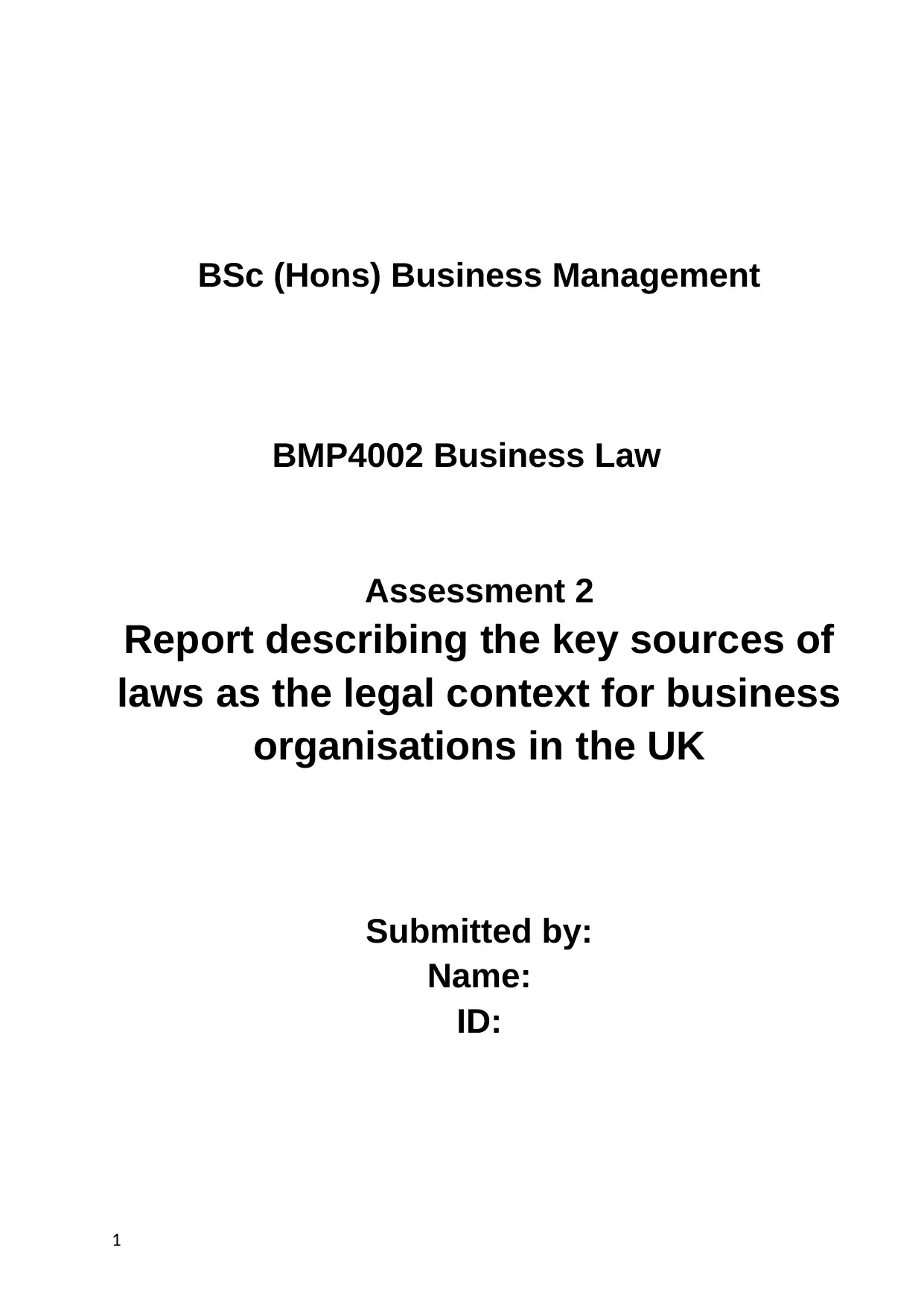
BSc (Hons) Business Management
BMP4002 Business Law
Assessment 2
Report describing the key sources of
laws as the legal context for business
organisations in the UK
Submitted by:
Name:
ID:
1
BMP4002 Business Law
Assessment 2
Report describing the key sources of
laws as the legal context for business
organisations in the UK
Submitted by:
Name:
ID:
1
Paraphrase This Document
Need a fresh take? Get an instant paraphrase of this document with our AI Paraphraser
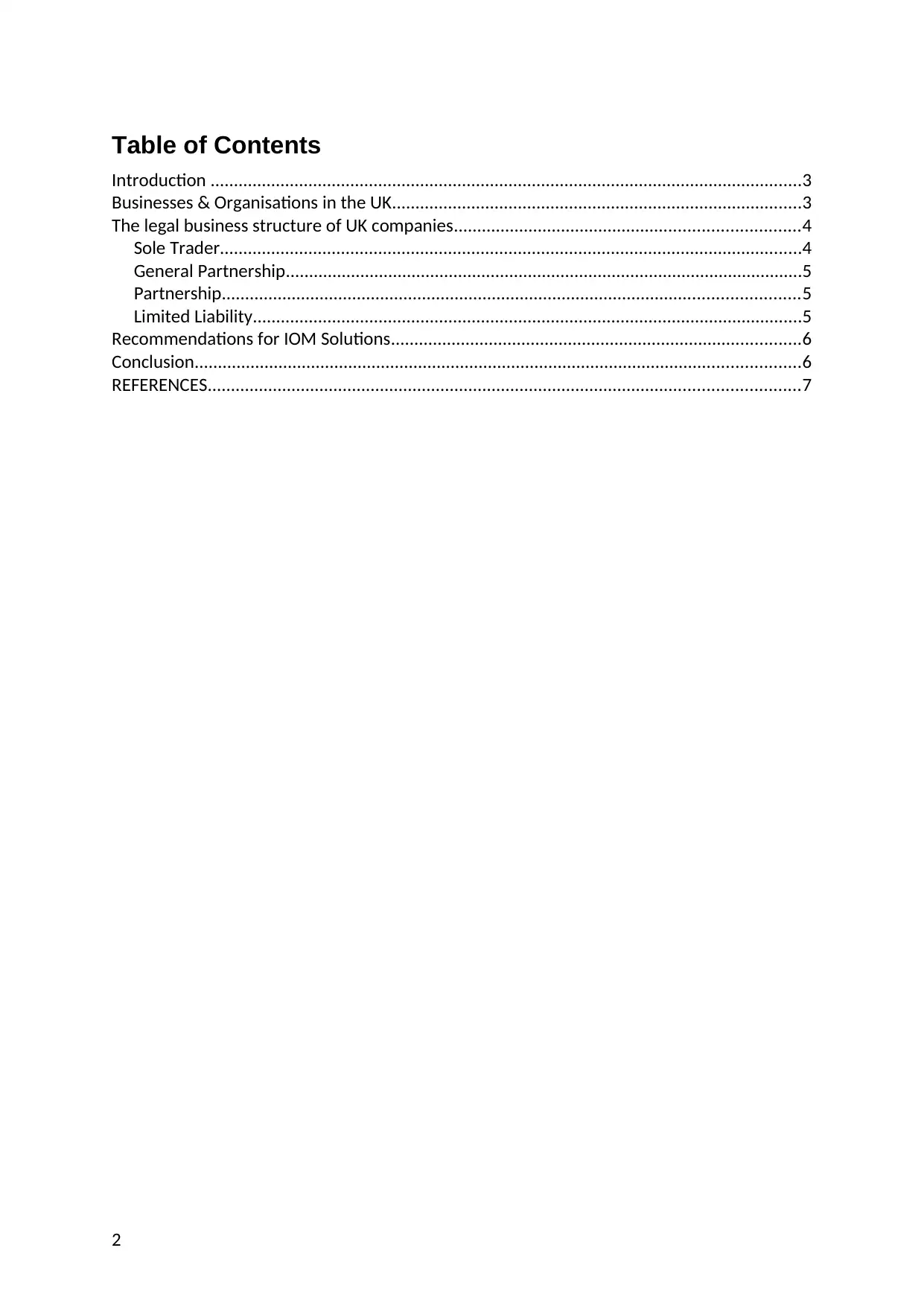
Table of Contents
Introduction ...............................................................................................................................3
Businesses & Organisations in the UK........................................................................................3
The legal business structure of UK companies..........................................................................4
Sole Trader.............................................................................................................................4
General Partnership...............................................................................................................5
Partnership............................................................................................................................5
Limited Liability......................................................................................................................5
Recommendations for IOM Solutions........................................................................................6
Conclusion..................................................................................................................................6
REFERENCES...............................................................................................................................7
2
Introduction ...............................................................................................................................3
Businesses & Organisations in the UK........................................................................................3
The legal business structure of UK companies..........................................................................4
Sole Trader.............................................................................................................................4
General Partnership...............................................................................................................5
Partnership............................................................................................................................5
Limited Liability......................................................................................................................5
Recommendations for IOM Solutions........................................................................................6
Conclusion..................................................................................................................................6
REFERENCES...............................................................................................................................7
2
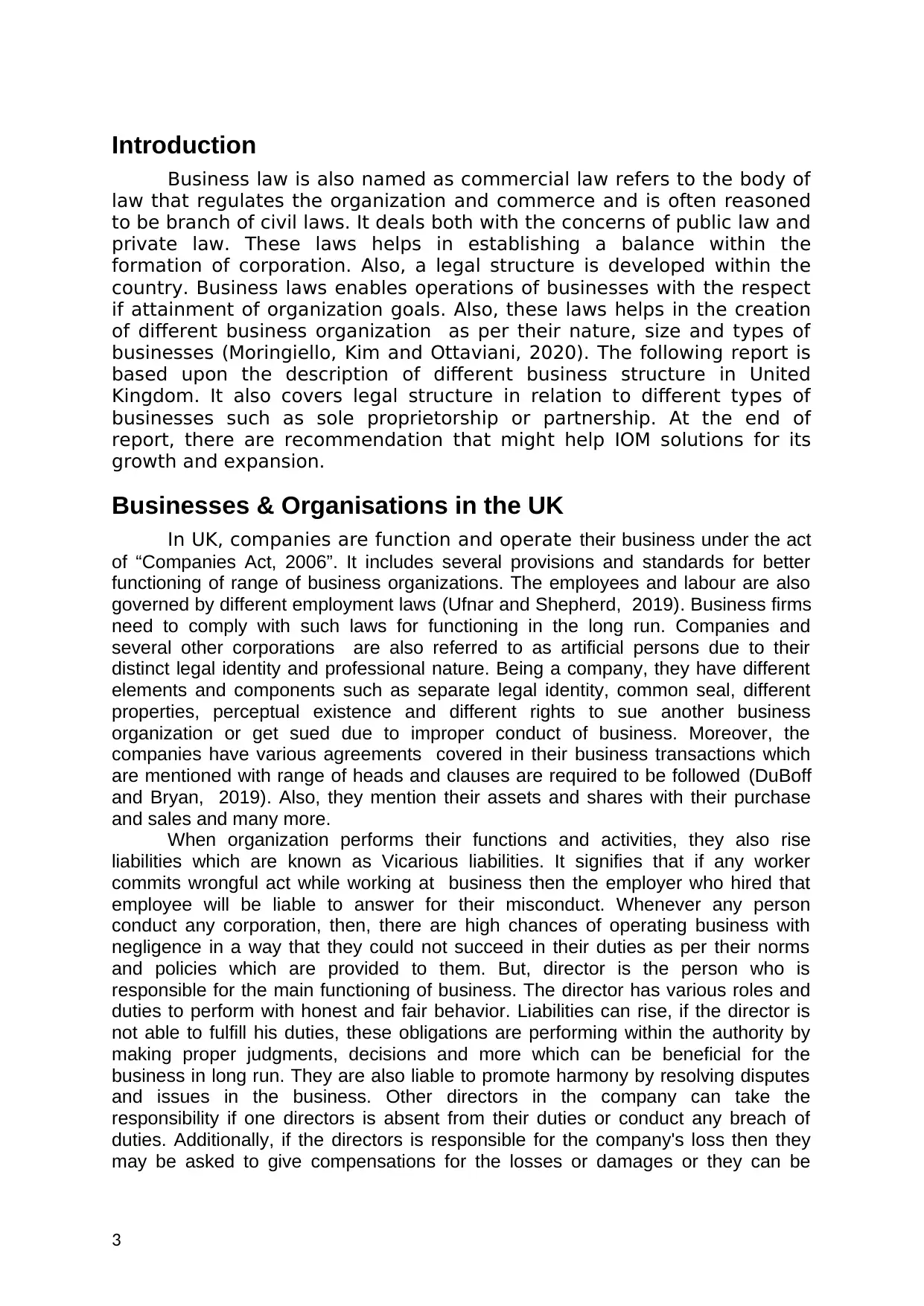
Introduction
Business law is also named as commercial law refers to the body of
law that regulates the organization and commerce and is often reasoned
to be branch of civil laws. It deals both with the concerns of public law and
private law. These laws helps in establishing a balance within the
formation of corporation. Also, a legal structure is developed within the
country. Business laws enables operations of businesses with the respect
if attainment of organization goals. Also, these laws helps in the creation
of different business organization as per their nature, size and types of
businesses (Moringiello, Kim and Ottaviani, 2020). The following report is
based upon the description of different business structure in United
Kingdom. It also covers legal structure in relation to different types of
businesses such as sole proprietorship or partnership. At the end of
report, there are recommendation that might help IOM solutions for its
growth and expansion.
Businesses & Organisations in the UK
In UK, companies are function and operate their business under the act
of “Companies Act, 2006”. It includes several provisions and standards for better
functioning of range of business organizations. The employees and labour are also
governed by different employment laws (Ufnar and Shepherd, 2019). Business firms
need to comply with such laws for functioning in the long run. Companies and
several other corporations are also referred to as artificial persons due to their
distinct legal identity and professional nature. Being a company, they have different
elements and components such as separate legal identity, common seal, different
properties, perceptual existence and different rights to sue another business
organization or get sued due to improper conduct of business. Moreover, the
companies have various agreements covered in their business transactions which
are mentioned with range of heads and clauses are required to be followed (DuBoff
and Bryan, 2019). Also, they mention their assets and shares with their purchase
and sales and many more.
When organization performs their functions and activities, they also rise
liabilities which are known as Vicarious liabilities. It signifies that if any worker
commits wrongful act while working at business then the employer who hired that
employee will be liable to answer for their misconduct. Whenever any person
conduct any corporation, then, there are high chances of operating business with
negligence in a way that they could not succeed in their duties as per their norms
and policies which are provided to them. But, director is the person who is
responsible for the main functioning of business. The director has various roles and
duties to perform with honest and fair behavior. Liabilities can rise, if the director is
not able to fulfill his duties, these obligations are performing within the authority by
making proper judgments, decisions and more which can be beneficial for the
business in long run. They are also liable to promote harmony by resolving disputes
and issues in the business. Other directors in the company can take the
responsibility if one directors is absent from their duties or conduct any breach of
duties. Additionally, if the directors is responsible for the company's loss then they
may be asked to give compensations for the losses or damages or they can be
3
Business law is also named as commercial law refers to the body of
law that regulates the organization and commerce and is often reasoned
to be branch of civil laws. It deals both with the concerns of public law and
private law. These laws helps in establishing a balance within the
formation of corporation. Also, a legal structure is developed within the
country. Business laws enables operations of businesses with the respect
if attainment of organization goals. Also, these laws helps in the creation
of different business organization as per their nature, size and types of
businesses (Moringiello, Kim and Ottaviani, 2020). The following report is
based upon the description of different business structure in United
Kingdom. It also covers legal structure in relation to different types of
businesses such as sole proprietorship or partnership. At the end of
report, there are recommendation that might help IOM solutions for its
growth and expansion.
Businesses & Organisations in the UK
In UK, companies are function and operate their business under the act
of “Companies Act, 2006”. It includes several provisions and standards for better
functioning of range of business organizations. The employees and labour are also
governed by different employment laws (Ufnar and Shepherd, 2019). Business firms
need to comply with such laws for functioning in the long run. Companies and
several other corporations are also referred to as artificial persons due to their
distinct legal identity and professional nature. Being a company, they have different
elements and components such as separate legal identity, common seal, different
properties, perceptual existence and different rights to sue another business
organization or get sued due to improper conduct of business. Moreover, the
companies have various agreements covered in their business transactions which
are mentioned with range of heads and clauses are required to be followed (DuBoff
and Bryan, 2019). Also, they mention their assets and shares with their purchase
and sales and many more.
When organization performs their functions and activities, they also rise
liabilities which are known as Vicarious liabilities. It signifies that if any worker
commits wrongful act while working at business then the employer who hired that
employee will be liable to answer for their misconduct. Whenever any person
conduct any corporation, then, there are high chances of operating business with
negligence in a way that they could not succeed in their duties as per their norms
and policies which are provided to them. But, director is the person who is
responsible for the main functioning of business. The director has various roles and
duties to perform with honest and fair behavior. Liabilities can rise, if the director is
not able to fulfill his duties, these obligations are performing within the authority by
making proper judgments, decisions and more which can be beneficial for the
business in long run. They are also liable to promote harmony by resolving disputes
and issues in the business. Other directors in the company can take the
responsibility if one directors is absent from their duties or conduct any breach of
duties. Additionally, if the directors is responsible for the company's loss then they
may be asked to give compensations for the losses or damages or they can be
3
⊘ This is a preview!⊘
Do you want full access?
Subscribe today to unlock all pages.

Trusted by 1+ million students worldwide
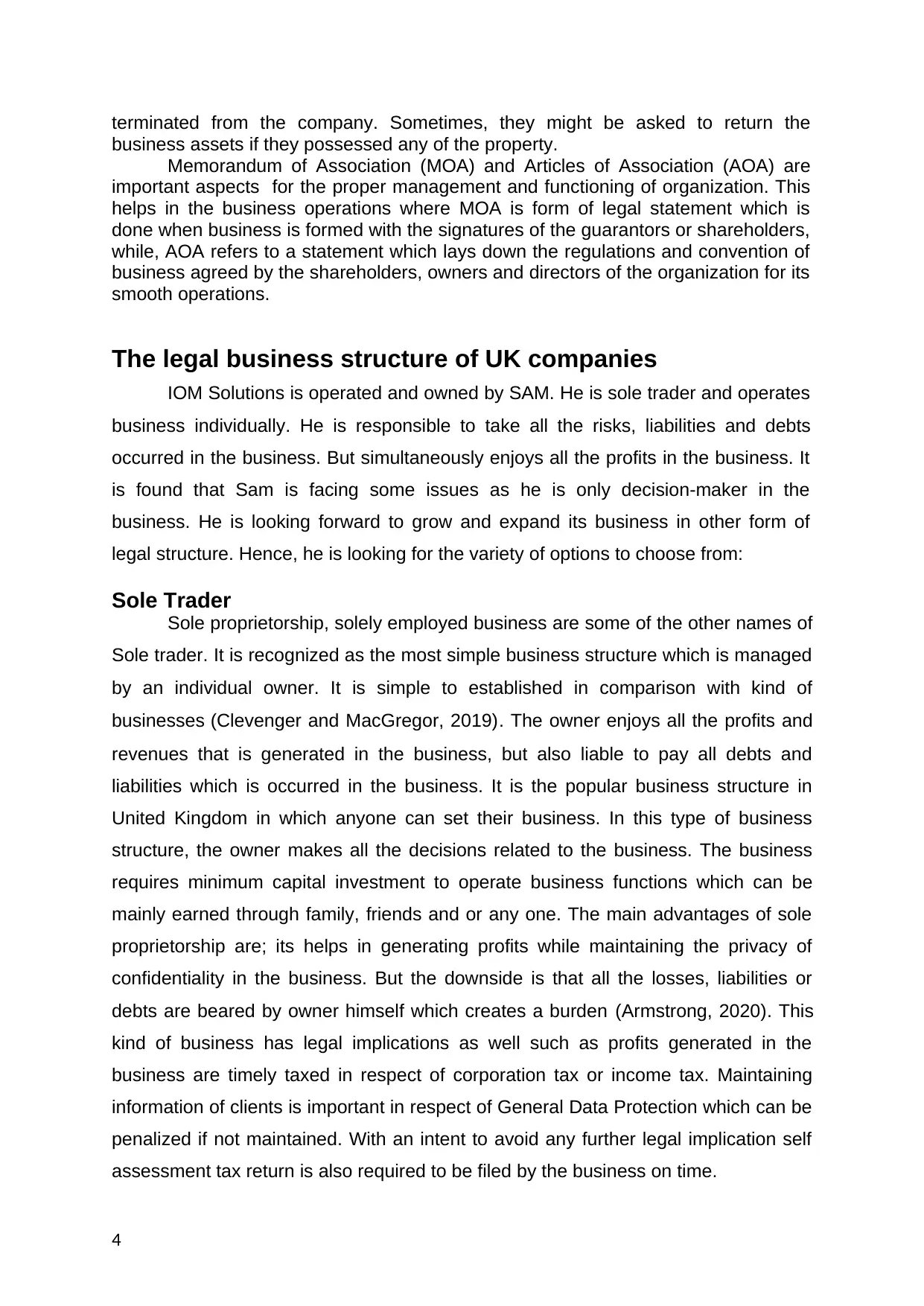
terminated from the company. Sometimes, they might be asked to return the
business assets if they possessed any of the property.
Memorandum of Association (MOA) and Articles of Association (AOA) are
important aspects for the proper management and functioning of organization. This
helps in the business operations where MOA is form of legal statement which is
done when business is formed with the signatures of the guarantors or shareholders,
while, AOA refers to a statement which lays down the regulations and convention of
business agreed by the shareholders, owners and directors of the organization for its
smooth operations.
The legal business structure of UK companies
IOM Solutions is operated and owned by SAM. He is sole trader and operates
business individually. He is responsible to take all the risks, liabilities and debts
occurred in the business. But simultaneously enjoys all the profits in the business. It
is found that Sam is facing some issues as he is only decision-maker in the
business. He is looking forward to grow and expand its business in other form of
legal structure. Hence, he is looking for the variety of options to choose from:
Sole Trader
Sole proprietorship, solely employed business are some of the other names of
Sole trader. It is recognized as the most simple business structure which is managed
by an individual owner. It is simple to established in comparison with kind of
businesses (Clevenger and MacGregor, 2019). The owner enjoys all the profits and
revenues that is generated in the business, but also liable to pay all debts and
liabilities which is occurred in the business. It is the popular business structure in
United Kingdom in which anyone can set their business. In this type of business
structure, the owner makes all the decisions related to the business. The business
requires minimum capital investment to operate business functions which can be
mainly earned through family, friends and or any one. The main advantages of sole
proprietorship are; its helps in generating profits while maintaining the privacy of
confidentiality in the business. But the downside is that all the losses, liabilities or
debts are beared by owner himself which creates a burden (Armstrong, 2020). This
kind of business has legal implications as well such as profits generated in the
business are timely taxed in respect of corporation tax or income tax. Maintaining
information of clients is important in respect of General Data Protection which can be
penalized if not maintained. With an intent to avoid any further legal implication self
assessment tax return is also required to be filed by the business on time.
4
business assets if they possessed any of the property.
Memorandum of Association (MOA) and Articles of Association (AOA) are
important aspects for the proper management and functioning of organization. This
helps in the business operations where MOA is form of legal statement which is
done when business is formed with the signatures of the guarantors or shareholders,
while, AOA refers to a statement which lays down the regulations and convention of
business agreed by the shareholders, owners and directors of the organization for its
smooth operations.
The legal business structure of UK companies
IOM Solutions is operated and owned by SAM. He is sole trader and operates
business individually. He is responsible to take all the risks, liabilities and debts
occurred in the business. But simultaneously enjoys all the profits in the business. It
is found that Sam is facing some issues as he is only decision-maker in the
business. He is looking forward to grow and expand its business in other form of
legal structure. Hence, he is looking for the variety of options to choose from:
Sole Trader
Sole proprietorship, solely employed business are some of the other names of
Sole trader. It is recognized as the most simple business structure which is managed
by an individual owner. It is simple to established in comparison with kind of
businesses (Clevenger and MacGregor, 2019). The owner enjoys all the profits and
revenues that is generated in the business, but also liable to pay all debts and
liabilities which is occurred in the business. It is the popular business structure in
United Kingdom in which anyone can set their business. In this type of business
structure, the owner makes all the decisions related to the business. The business
requires minimum capital investment to operate business functions which can be
mainly earned through family, friends and or any one. The main advantages of sole
proprietorship are; its helps in generating profits while maintaining the privacy of
confidentiality in the business. But the downside is that all the losses, liabilities or
debts are beared by owner himself which creates a burden (Armstrong, 2020). This
kind of business has legal implications as well such as profits generated in the
business are timely taxed in respect of corporation tax or income tax. Maintaining
information of clients is important in respect of General Data Protection which can be
penalized if not maintained. With an intent to avoid any further legal implication self
assessment tax return is also required to be filed by the business on time.
4
Paraphrase This Document
Need a fresh take? Get an instant paraphrase of this document with our AI Paraphraser
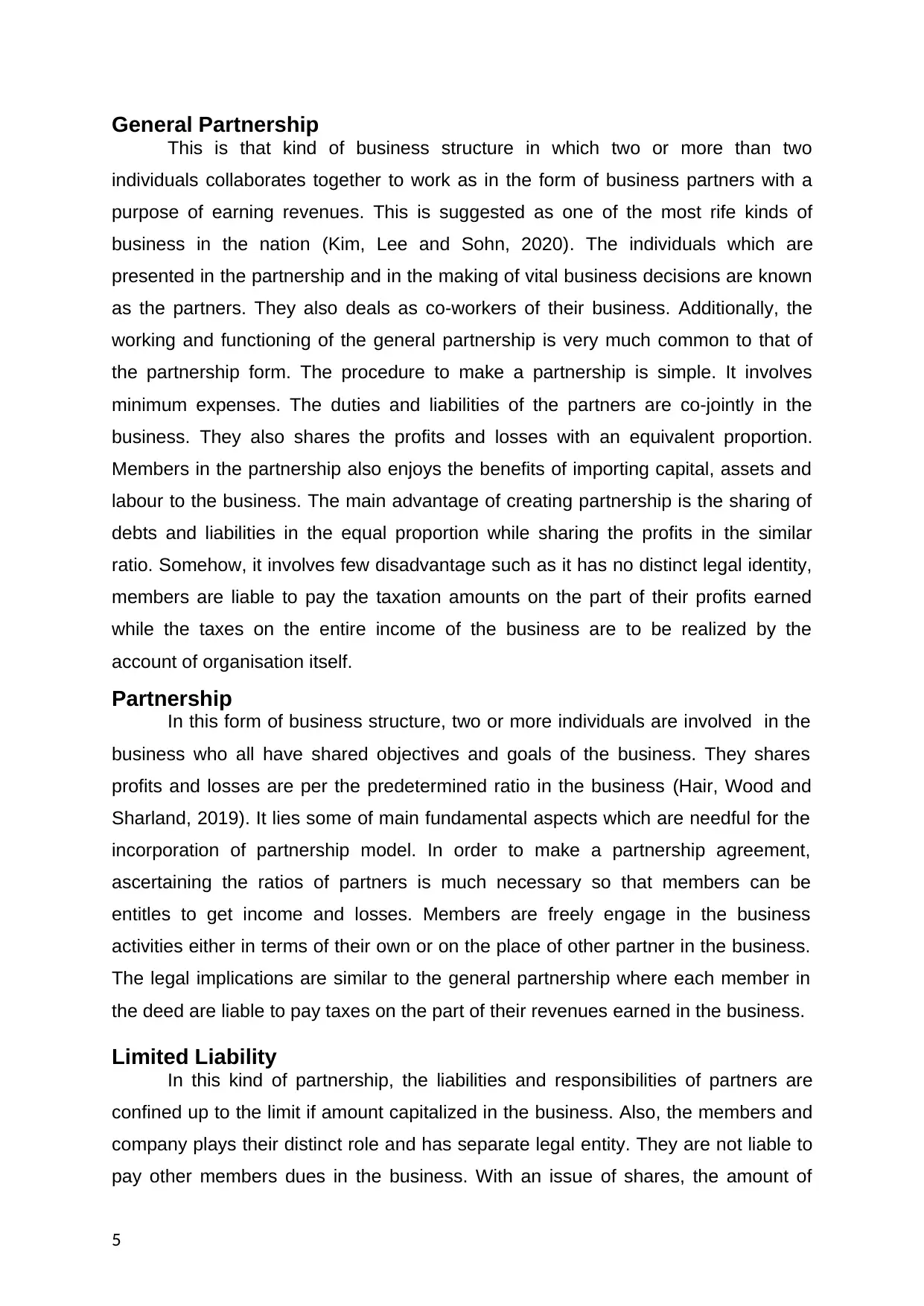
General Partnership
This is that kind of business structure in which two or more than two
individuals collaborates together to work as in the form of business partners with a
purpose of earning revenues. This is suggested as one of the most rife kinds of
business in the nation (Kim, Lee and Sohn, 2020). The individuals which are
presented in the partnership and in the making of vital business decisions are known
as the partners. They also deals as co-workers of their business. Additionally, the
working and functioning of the general partnership is very much common to that of
the partnership form. The procedure to make a partnership is simple. It involves
minimum expenses. The duties and liabilities of the partners are co-jointly in the
business. They also shares the profits and losses with an equivalent proportion.
Members in the partnership also enjoys the benefits of importing capital, assets and
labour to the business. The main advantage of creating partnership is the sharing of
debts and liabilities in the equal proportion while sharing the profits in the similar
ratio. Somehow, it involves few disadvantage such as it has no distinct legal identity,
members are liable to pay the taxation amounts on the part of their profits earned
while the taxes on the entire income of the business are to be realized by the
account of organisation itself.
Partnership
In this form of business structure, two or more individuals are involved in the
business who all have shared objectives and goals of the business. They shares
profits and losses are per the predetermined ratio in the business (Hair, Wood and
Sharland, 2019). It lies some of main fundamental aspects which are needful for the
incorporation of partnership model. In order to make a partnership agreement,
ascertaining the ratios of partners is much necessary so that members can be
entitles to get income and losses. Members are freely engage in the business
activities either in terms of their own or on the place of other partner in the business.
The legal implications are similar to the general partnership where each member in
the deed are liable to pay taxes on the part of their revenues earned in the business.
Limited Liability
In this kind of partnership, the liabilities and responsibilities of partners are
confined up to the limit if amount capitalized in the business. Also, the members and
company plays their distinct role and has separate legal entity. They are not liable to
pay other members dues in the business. With an issue of shares, the amount of
5
This is that kind of business structure in which two or more than two
individuals collaborates together to work as in the form of business partners with a
purpose of earning revenues. This is suggested as one of the most rife kinds of
business in the nation (Kim, Lee and Sohn, 2020). The individuals which are
presented in the partnership and in the making of vital business decisions are known
as the partners. They also deals as co-workers of their business. Additionally, the
working and functioning of the general partnership is very much common to that of
the partnership form. The procedure to make a partnership is simple. It involves
minimum expenses. The duties and liabilities of the partners are co-jointly in the
business. They also shares the profits and losses with an equivalent proportion.
Members in the partnership also enjoys the benefits of importing capital, assets and
labour to the business. The main advantage of creating partnership is the sharing of
debts and liabilities in the equal proportion while sharing the profits in the similar
ratio. Somehow, it involves few disadvantage such as it has no distinct legal identity,
members are liable to pay the taxation amounts on the part of their profits earned
while the taxes on the entire income of the business are to be realized by the
account of organisation itself.
Partnership
In this form of business structure, two or more individuals are involved in the
business who all have shared objectives and goals of the business. They shares
profits and losses are per the predetermined ratio in the business (Hair, Wood and
Sharland, 2019). It lies some of main fundamental aspects which are needful for the
incorporation of partnership model. In order to make a partnership agreement,
ascertaining the ratios of partners is much necessary so that members can be
entitles to get income and losses. Members are freely engage in the business
activities either in terms of their own or on the place of other partner in the business.
The legal implications are similar to the general partnership where each member in
the deed are liable to pay taxes on the part of their revenues earned in the business.
Limited Liability
In this kind of partnership, the liabilities and responsibilities of partners are
confined up to the limit if amount capitalized in the business. Also, the members and
company plays their distinct role and has separate legal entity. They are not liable to
pay other members dues in the business. With an issue of shares, the amount of
5
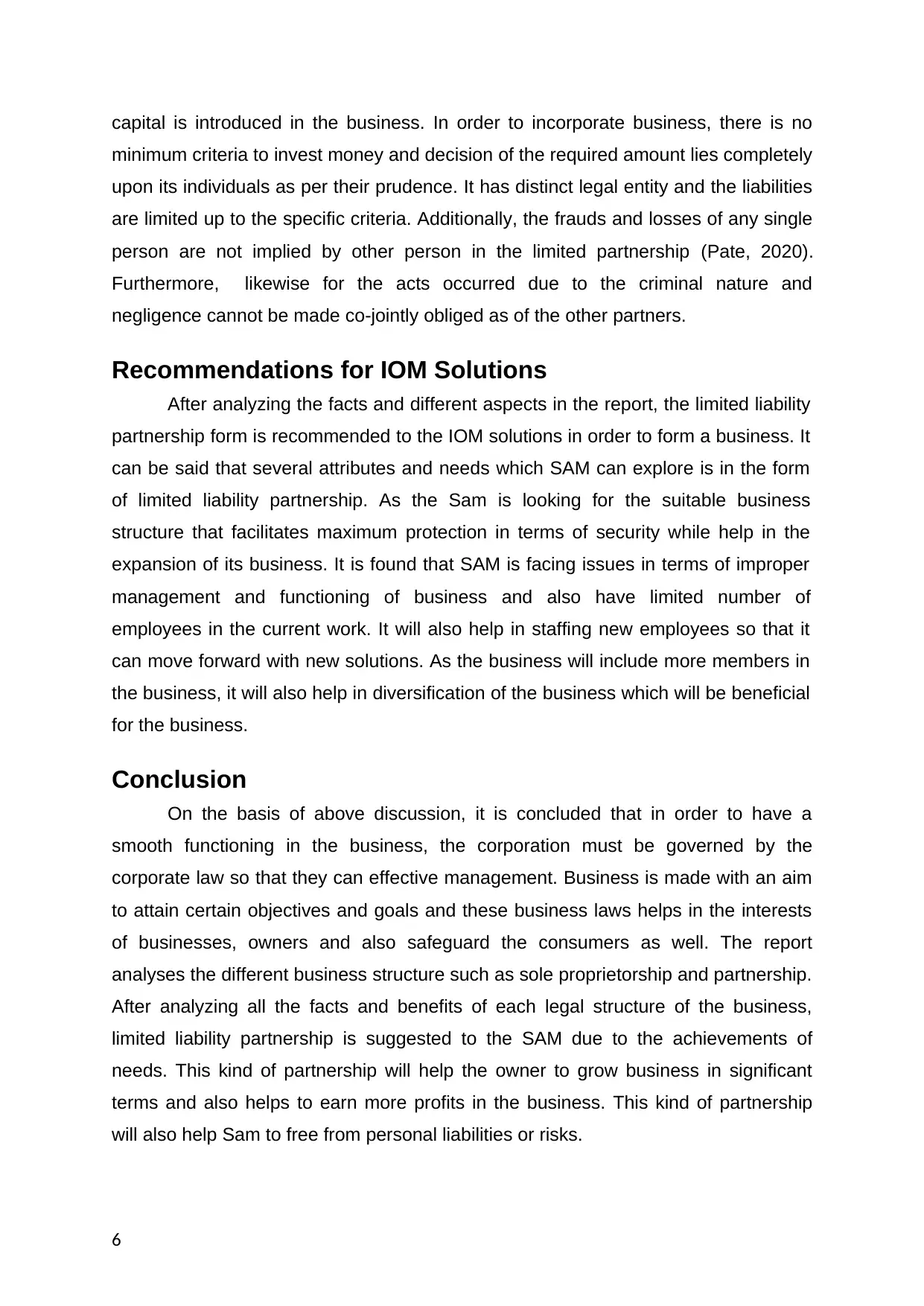
capital is introduced in the business. In order to incorporate business, there is no
minimum criteria to invest money and decision of the required amount lies completely
upon its individuals as per their prudence. It has distinct legal entity and the liabilities
are limited up to the specific criteria. Additionally, the frauds and losses of any single
person are not implied by other person in the limited partnership (Pate, 2020).
Furthermore, likewise for the acts occurred due to the criminal nature and
negligence cannot be made co-jointly obliged as of the other partners.
Recommendations for IOM Solutions
After analyzing the facts and different aspects in the report, the limited liability
partnership form is recommended to the IOM solutions in order to form a business. It
can be said that several attributes and needs which SAM can explore is in the form
of limited liability partnership. As the Sam is looking for the suitable business
structure that facilitates maximum protection in terms of security while help in the
expansion of its business. It is found that SAM is facing issues in terms of improper
management and functioning of business and also have limited number of
employees in the current work. It will also help in staffing new employees so that it
can move forward with new solutions. As the business will include more members in
the business, it will also help in diversification of the business which will be beneficial
for the business.
Conclusion
On the basis of above discussion, it is concluded that in order to have a
smooth functioning in the business, the corporation must be governed by the
corporate law so that they can effective management. Business is made with an aim
to attain certain objectives and goals and these business laws helps in the interests
of businesses, owners and also safeguard the consumers as well. The report
analyses the different business structure such as sole proprietorship and partnership.
After analyzing all the facts and benefits of each legal structure of the business,
limited liability partnership is suggested to the SAM due to the achievements of
needs. This kind of partnership will help the owner to grow business in significant
terms and also helps to earn more profits in the business. This kind of partnership
will also help Sam to free from personal liabilities or risks.
6
minimum criteria to invest money and decision of the required amount lies completely
upon its individuals as per their prudence. It has distinct legal entity and the liabilities
are limited up to the specific criteria. Additionally, the frauds and losses of any single
person are not implied by other person in the limited partnership (Pate, 2020).
Furthermore, likewise for the acts occurred due to the criminal nature and
negligence cannot be made co-jointly obliged as of the other partners.
Recommendations for IOM Solutions
After analyzing the facts and different aspects in the report, the limited liability
partnership form is recommended to the IOM solutions in order to form a business. It
can be said that several attributes and needs which SAM can explore is in the form
of limited liability partnership. As the Sam is looking for the suitable business
structure that facilitates maximum protection in terms of security while help in the
expansion of its business. It is found that SAM is facing issues in terms of improper
management and functioning of business and also have limited number of
employees in the current work. It will also help in staffing new employees so that it
can move forward with new solutions. As the business will include more members in
the business, it will also help in diversification of the business which will be beneficial
for the business.
Conclusion
On the basis of above discussion, it is concluded that in order to have a
smooth functioning in the business, the corporation must be governed by the
corporate law so that they can effective management. Business is made with an aim
to attain certain objectives and goals and these business laws helps in the interests
of businesses, owners and also safeguard the consumers as well. The report
analyses the different business structure such as sole proprietorship and partnership.
After analyzing all the facts and benefits of each legal structure of the business,
limited liability partnership is suggested to the SAM due to the achievements of
needs. This kind of partnership will help the owner to grow business in significant
terms and also helps to earn more profits in the business. This kind of partnership
will also help Sam to free from personal liabilities or risks.
6
⊘ This is a preview!⊘
Do you want full access?
Subscribe today to unlock all pages.

Trusted by 1+ million students worldwide
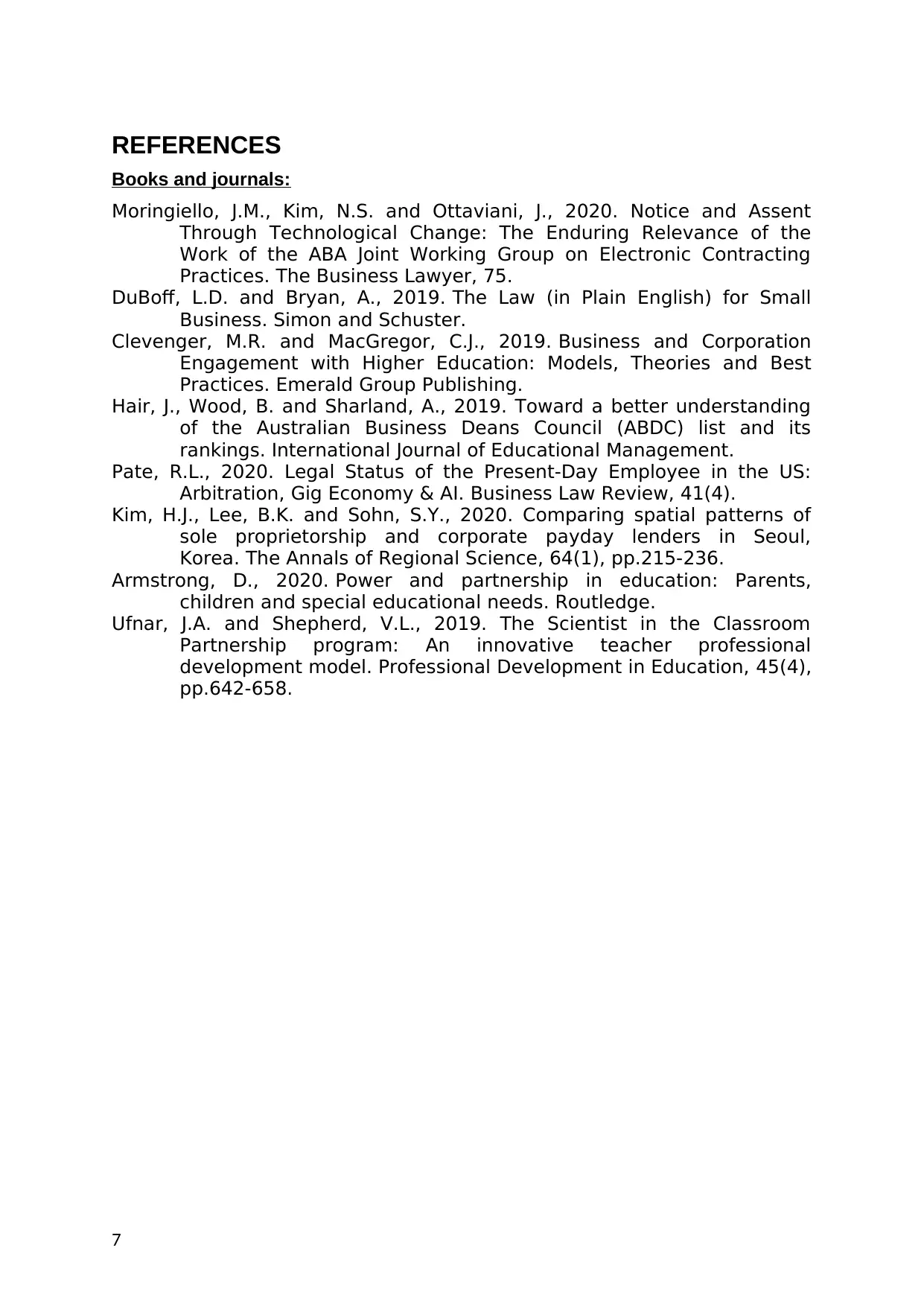
REFERENCES
Books and journals:
Moringiello, J.M., Kim, N.S. and Ottaviani, J., 2020. Notice and Assent
Through Technological Change: The Enduring Relevance of the
Work of the ABA Joint Working Group on Electronic Contracting
Practices. The Business Lawyer, 75.
DuBoff, L.D. and Bryan, A., 2019. The Law (in Plain English) for Small
Business. Simon and Schuster.
Clevenger, M.R. and MacGregor, C.J., 2019. Business and Corporation
Engagement with Higher Education: Models, Theories and Best
Practices. Emerald Group Publishing.
Hair, J., Wood, B. and Sharland, A., 2019. Toward a better understanding
of the Australian Business Deans Council (ABDC) list and its
rankings. International Journal of Educational Management.
Pate, R.L., 2020. Legal Status of the Present-Day Employee in the US:
Arbitration, Gig Economy & AI. Business Law Review, 41(4).
Kim, H.J., Lee, B.K. and Sohn, S.Y., 2020. Comparing spatial patterns of
sole proprietorship and corporate payday lenders in Seoul,
Korea. The Annals of Regional Science, 64(1), pp.215-236.
Armstrong, D., 2020. Power and partnership in education: Parents,
children and special educational needs. Routledge.
Ufnar, J.A. and Shepherd, V.L., 2019. The Scientist in the Classroom
Partnership program: An innovative teacher professional
development model. Professional Development in Education, 45(4),
pp.642-658.
7
Books and journals:
Moringiello, J.M., Kim, N.S. and Ottaviani, J., 2020. Notice and Assent
Through Technological Change: The Enduring Relevance of the
Work of the ABA Joint Working Group on Electronic Contracting
Practices. The Business Lawyer, 75.
DuBoff, L.D. and Bryan, A., 2019. The Law (in Plain English) for Small
Business. Simon and Schuster.
Clevenger, M.R. and MacGregor, C.J., 2019. Business and Corporation
Engagement with Higher Education: Models, Theories and Best
Practices. Emerald Group Publishing.
Hair, J., Wood, B. and Sharland, A., 2019. Toward a better understanding
of the Australian Business Deans Council (ABDC) list and its
rankings. International Journal of Educational Management.
Pate, R.L., 2020. Legal Status of the Present-Day Employee in the US:
Arbitration, Gig Economy & AI. Business Law Review, 41(4).
Kim, H.J., Lee, B.K. and Sohn, S.Y., 2020. Comparing spatial patterns of
sole proprietorship and corporate payday lenders in Seoul,
Korea. The Annals of Regional Science, 64(1), pp.215-236.
Armstrong, D., 2020. Power and partnership in education: Parents,
children and special educational needs. Routledge.
Ufnar, J.A. and Shepherd, V.L., 2019. The Scientist in the Classroom
Partnership program: An innovative teacher professional
development model. Professional Development in Education, 45(4),
pp.642-658.
7
1 out of 7
Related Documents
Your All-in-One AI-Powered Toolkit for Academic Success.
+13062052269
info@desklib.com
Available 24*7 on WhatsApp / Email
![[object Object]](/_next/static/media/star-bottom.7253800d.svg)
Unlock your academic potential
Copyright © 2020–2025 A2Z Services. All Rights Reserved. Developed and managed by ZUCOL.
